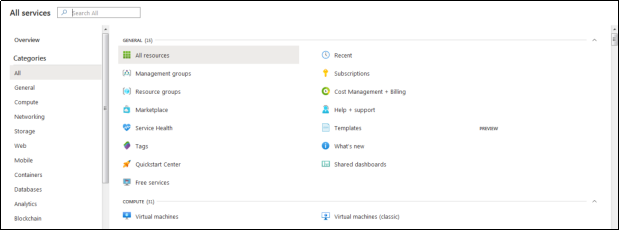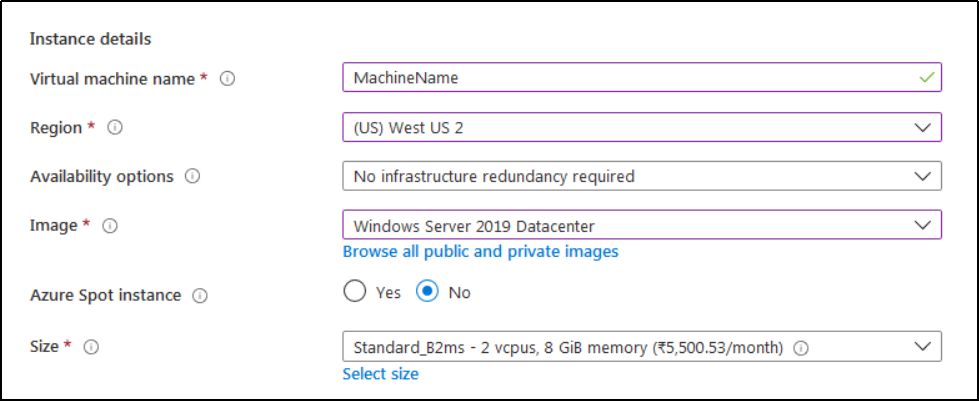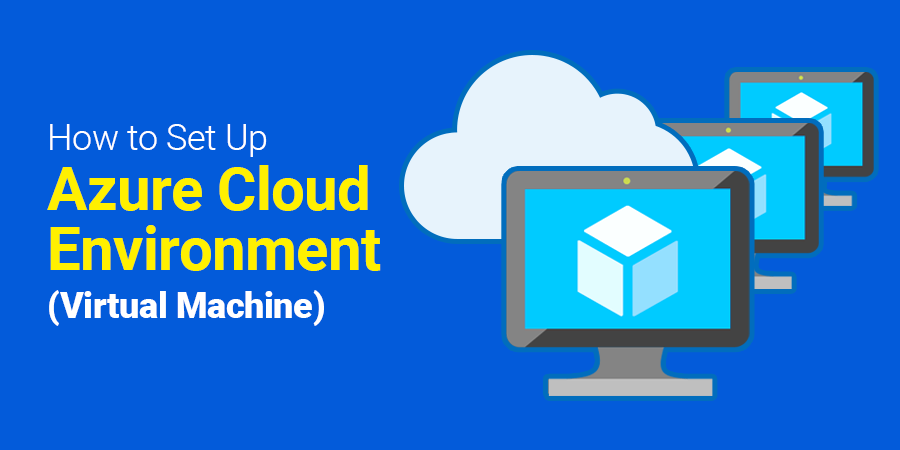Azure Virtual Machines (VMs) are one of the on-demand computing resources offered by Microsoft Azure. Based on Infrastructure as a Service (IaaS), Azure VM empowers users with more control over the environment to customize the development or hosting environment. A user can work on it and shut it down whenever they need it. Using Azure VM, you can create application services, SQL databases, Linux virtual machines, directory domain services, and many more. At the same time, you need to configure, patch, and install the software that runs on it.
What are the types of Azure VMs?
The following table lists common types of Azure VMs with their features and applications.
| Type of Azure VM | Features | Applications |
| General Purpose | Balanced CPU to memory ratio | Testing and deployment of small to medium databases |
| Compute Optimized | High CPU to memory ratio | Medium traffic web servers, application servers, and network equipment |
| Memory Optimized | High memory to CPU ratio | Relational database servers, memory analytics, medium to large caches |
| Storage Optimized | High disk throughput and IO | Data warehousing, SQL, NoSQL, Big Data and big transactional databases |
| GPU | Specialized for video editing and heavy graphics rendering | Modern training and differencing with deep learning |
| High-Performance Compute | Fastest and powerful CPU | High throughput network interfaces (RDMA) |
The design consideration is crucial for the effective building of application infrastructure in Azure. Following are the factors you should consider before creating Azure VM –
- Application resources names on an Azure VM
- Storage resources location
- VM size
- Maximum number of VMs that can be created
- VM configuration after starting
- Operating system run by the VM
- Related resources required by the VM
Steps to Create Windows Virtual Machine
Following are some steps to create a basic Azure Virtual Machine.
1.Log in to the Azure portal.
2.Click on the top left menu and select All Services.

3.Select Virtual machines under Compute.

4.A list of existing Virtual Machines will be displayed. Click on Add to create a new Virtual Machine

5.Fill up the following details under the Basics tab.
5.1.Under Project Details, choose the correct subscription.
5.2.Select the Create new resource group and type the name of your resource group, such as myResourceGroup.

6.Under Instance Details, enter Virtual machine name such as MachineName.
6.1.Select your Region, such as West US. This setting is significant for minimizing data latency. You have to select the region that is closest to you geographically.
6.2.Select the image of the required Operating System, e.g., Windows Server 2019 Datacenter.
6.3.Leave the other defaults.
6.4.If you want to benefit from Azure’s unused capacity at significant cost savings, you can select the value for Azure Spot instance as ‘Yes’. Spot VMs are ideal for a workload that can manage interruptions such as large compute workload, dev/test environments, batch processing jobs, etc. The available capacity varies for criteria, including regions, sizes, time of the day, and more, and based on this, Azure will deploy Spot VMs. When needed, Azure infrastructure will evict Spot VMs with 30 seconds notice.

7.Under the Administrator Account, type username, and password. The password should comply with the defined complexity requirements and have a minimum length of 12 characters.

8.Under Inbound port rules, ensure that RDP (3389) is selected by default under Allow selected ports.

9.Leave the remaining defaults and select the Review + create button at the bottom.

With the steps mentioned above, you can quickly create an Azure VM. You can further fine-tune it using more options as follows –
- Disks – It allows you to select disk type for OS and also attach more data disks. Azure supports two types of disks – HDD that provides cost-effective storage for dev and test workload and SSD-based low latency and high-performance disk for production workload.
- Networking – This option helps you configure the networking aspects. In an Azure virtual network, you can filter network traffic to and from Azure resources using the NIC Network Security Group. When you see ‘RDP 3389’ in Select inbound ports, it means that all IP addresses can access your virtual machine, which is recommended only for testing. You can change this by creating rules using the Advanced controls in the Networking tab. Likewise, you can select whether you need to avail of Accelerated networking and Load balancing options.
- Management – Besides providing the configuration option for various diagnostics, this tab contains the options that let you decide to enable backup and auto-shutdown.
- Advanced – The tab contains advanced features, including extensions, host group, proximity placement group, VM generation, and many more.
- Tags – These are the name-value pairs. They help categorize resources and are useful in automation, access control, and compliance, and cost governance.
In this blog, we discussed creating an Azure VM for Windows Server. Likewise, Azure allows you to create images for other operating systems like Linux, databases like SQL Server, and many more. For availing the optimum benefits, you need to configure your Azure VM properly. With a broad range of configuration options, creating an Azure VM can be overwhelming. WaferWire Cloud Technologies can help you select the best suitable options for your organization. Contact us and our technical team will help you get the most out of your Azure investment.

